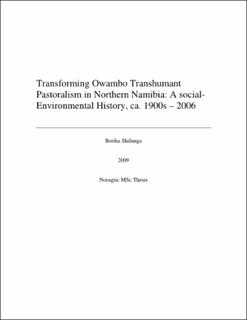| dc.description.abstract | Transhumant pastoralism in north-central Namibia, the former Owambo, was explored from a historical perspective, using the theory of socio-environmental history as a framework. The study used secondary data, informal interviews and discussions, and for recent times, interviews with herders. The change or transformation of transhumant pastoralism in Ohangwena was analysed from three phases, namely, the period before colonialism, during colonialism and after Independence. The goal was to understand how transhumance has been transformed over the years and factors responsible for such transformations.
The study shows that livestock mobility in north-central Namibia involved nearly 70-90 per cent of cattle in transhumant migrations. However, the transhumance has changed in scope and extent of movements at geographical scales over the periods under consideration from 1900 to 2006. Some of the traditional routes of migrations have been retained. Since colonial times, particularly during the German rule in Namibia, the changes in transhumant pastoralism were more to man-made than natural causes. During the colonial administration Owambo pastoralism was never understood. In combination with other factors such as political factors, this led to the neglect of agriculture and pastoralism in the north-central regions.
The change in livestock mobility is mainly connected to the decrease in rangeland size and communal grazing, the change in communal land rights, introduction of new cattle breeds, adoption of new cattle ranching methods and shortage of professional herdsmen. The rangeland has decreased mainly due to establishment of clearly-defined artificial borders, animal control-fences such as veterinary cordon fence (VCF), introduction of sedentary agriculture in previously grazing reserves, the change in patterns of human settlements and so forth. The change in communal grazing, which has decreased by 20 per cent, and grazing rights is mainly caused by the development and extension of modern infrastructures such as water pipelines, the privatization (enclosures) of large areas of communal land, and weakened power and capacity of traditional rulers on management of grazing and land. The migration of men mainly for formal paid jobs and participation in war has contributed to the shortage of Owambo professional herdsmen to implement transhumant migrations. Since communal grazing and the rangeland have decreased, transhumant pastoralists have been experiencing difficulties with regards to sufficient grazing and livestock mobility. Conflicts associated with grazing resources have become common in the northern Namibia because of more demands for private land and competition for scarce resources among different land users. Land-related conflicts have affected relationships between different ethnic groups and territories or regions. In the long term this can easily result in the politicization of land-related conflicts which in turn can affect the relationship between poor herders and the elites particularly political elites (whose aim is the privatization of land), and the relationship between pastoralists and the state. Environmental conditions will also be affected if future decisions are unfavourable for transhumant pastoralism. | en_US |

